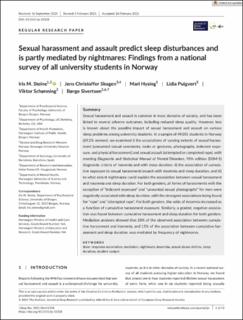Sexual harassment and assault predict sleep disturbances and is partly mediated by nightmares: Findings from a national survey of all university students in Norway
| dc.contributor.author | Steine, Iris Mulders | |
| dc.contributor.author | Skogen, Jens Christoffer | |
| dc.contributor.author | Hysing, Mari | |
| dc.contributor.author | Puigvert, Lidia | |
| dc.contributor.author | Schønning, Viktor | |
| dc.contributor.author | Sivertsen, Børge | |
| dc.date.accessioned | 2022-02-07T09:09:50Z | |
| dc.date.available | 2022-02-07T09:09:50Z | |
| dc.date.created | 2021-07-15T17:43:37Z | |
| dc.date.issued | 2021 | |
| dc.identifier.citation | Journal of Sleep Research. 2021, 30 (6), . | en_US |
| dc.identifier.issn | 0962-1105 | |
| dc.identifier.uri | https://hdl.handle.net/11250/2977397 | |
| dc.description.abstract | Sexual harassment and assault is common in most domains of society, and has been linked to several adverse outcomes, including reduced sleep quality. However, less is known about the possible impact of sexual harassment and assault on various sleep problems among university students. In a sample of 49,051 students in Norway (69.2% women), we examined i) the associations of varying extents of sexual harassment (unwanted sexual comments, looks or gestures, photographs, indecent exposure, and physical harassment) and sexual assault (attempted or completed rape), with meeting Diagnostic and Statistical Manual of Mental Disorders, fifth edition (DSM-5) diagnostic criteria of insomnia and with sleep duration, ii) the association of cumulative exposure to sexual harassment/assault with insomnia and sleep duration, and iii) to what extent nightmares could explain the association between sexual harassment and insomnia and sleep duration. For both genders, all forms of harassments with the exception of “indecent exposure” and “unwanted sexual photographs” for men were negatively associated with sleep duration, with the strongest associations being found for “rape” and “attempted rape”. For both genders, the odds of insomnia increased as a function of cumulative harassment exposure. Similarly, a graded, negative association was found between cumulative harassment and sleep duration for both genders. Mediation analyses showed that 28% of the observed association between cumulative harassment and insomnia, and 15% of the association between cumulative harassment and sleep duration, was mediated by frequency of nightmares. | en_US |
| dc.language.iso | eng | en_US |
| dc.publisher | Wiley | en_US |
| dc.rights | Navngivelse 4.0 Internasjonal | * |
| dc.rights.uri | http://creativecommons.org/licenses/by/4.0/deed.no | * |
| dc.title | Sexual harassment and assault predict sleep disturbances and is partly mediated by nightmares: Findings from a national survey of all university students in Norway | en_US |
| dc.type | Journal article | en_US |
| dc.type | Peer reviewed | en_US |
| dc.description.version | publishedVersion | en_US |
| dc.source.pagenumber | 13 | en_US |
| dc.source.volume | 30 | en_US |
| dc.source.journal | Journal of Sleep Research | en_US |
| dc.source.issue | 6 | en_US |
| dc.identifier.doi | 10.1111/jsr.13338 | |
| dc.identifier.cristin | 1921899 | |
| dc.relation.project | Kunnskapsdepartementet: - | en_US |
| dc.relation.project | Helse- og omsorgsdepartementet: - | en_US |
| cristin.ispublished | true | |
| cristin.fulltext | original | |
| cristin.qualitycode | 1 |
Tilhørende fil(er)
Denne innførselen finnes i følgende samling(er)
-
Institutt for psykisk helse [1312]
-
Publikasjoner fra CRIStin - NTNU [38672]

